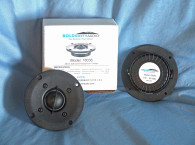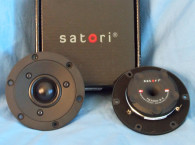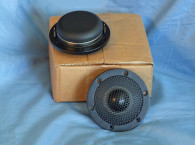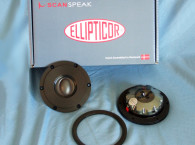
Additional features for the TSCT 1044 include a 28 mm Acuflex hand-coated fabric dome, a 104 mm IDR metal faceplate, a vented “flat pancake” ring-type neodymium magnet structure, a Hexatech hexagonal shaped aluminum voice coil wire (originally licensed from Dynaudio) wound on a titanium former, an underhung 1.125” diameter voice coil (4 mm gap and 2 mm coil height), a replaceable voice coil assembly, a damped die cast aluminum rear cavity, magnetic fluid in the gap for enhanced cooling, and gold-plated terminals. Because of the motor configuration, the top of the magnetic return path (pole piece) is about 60% open, providing a relatively small reflective surface beneath the dome. The remaining surface is damped with a round “donut” shaped felt ring. Last, the Din power handling specification for this tweeter is a robust 200 W.





To begin, I created an impedance plot using a LMS 300-point impedance sine wave sweep (see Figure 1). The tweeter resonance occurs at 594 Hz, with the obvious damping from the large rear cavity and magnetic fluid. With a REVC =4.04 Ω, the minimum impedance for this tweeter is 4.56 Ω at 5.2 kHz.
I recess mounted the TSCT 1044 in an enclosure that had a baffle area of about 17” × 8” and measured the on- and off-axis frequency response at 2.83 V/1 m with a 100-point gated sine wave sweep from 40 kHz to 300 Hz. Figure 2 shows the on-axis response. The TSCT 1044’s frequency response is a gently rising slope and a smooth ±2.2 dB from 1.5 kHz to 10 kHz, with the low-pass rolloff beginning at about 20 kHz. Figure 3 depicts the TSCT 1044’s on- and off-axis response.
You can easily see the effect of the Morel-shaped IDR faceplate. Off-axis, the device is only –3 dB down at 13 kHz from the on-axis response with respect to the 30° off-axis curve and –4 dB at 45° off-axis (also at 13 kHz), again with respect to the 30° off-axis response. This is a nice improvement over the typical 1” soft dome type tweeter off-axis response above 10 kHz. Figure 4 shows another view of the off-axis response in the normalized on- and off-axis plot. Figure 5 gives the two-sample SPL comparison, indicating the two samples were well matched. Of course this is the kind of consistency you expect from a company such as Morel.
Next, I used the Listen, Inc., SoundCheck analyzer to measure the impulse response with the tweeter recess mounted on the same baffle that I used to measure the TSCT 1044’s frequency response. Importing this data in the Listen SoundMap software produced the cumulative spectral decay plot (waterfall) shown in Figure 6. Figure 7 shows the Short Time Fourier Transform (STFT) displayed as a multi-color surface plot. Last, I set the 1 m sound pressure level (SPL) to 94 dB (3.03 V), and the analyzer range to 1 kHz to 20 kHz. Then, I measured the second and third harmonic distortion at 10 cm (see Figure 8). The new TSCT 1044 is another well-conceived tweeter from Morel engineering. For more information on the TSCT 1044 tweeter and other Morel OEM drivers, visit www.morelhifi.com.



This article was originally published in Voice Coil, February 2016.







